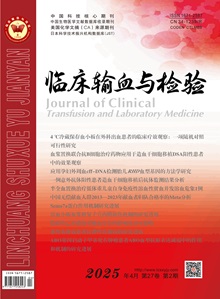|
|
Analysis of HLA/HPA Antibody Specificity and Its Impact on Platelet Transfusion Outcomes in Patients with Immune Platelet Transfusion Refractoriness
FAN Chengyan, WEN Yujie, ZHANG Dan, LIAN Xue, LIU Na, SUN Tiecheng, WANG Dongmei, JIA Yanjun, LI Dongmei
JOURNAL OF CLINICAL TRANSFUSION AND LABORATORY MEDICINE
2024, 26 (3):
353-358.
DOI: 10.3969/j.issn.1671-2587.2024.03.009
Objective To analyze the distribution of HLA/HPA antibody specificity and its influence on the efficacy of platelet transfusion in patients with immune platelet transfusion refractoriness(PTR).
Methods In this study, 86 patients with immune PTR were recruited, and clinical data were collected, including gender, age, height, weight, times of platelet cross-matching, diseases, as well as platelet count before and after platelet transfusion. HLA antibody specificity was determined using the microbead assay.
Results Among 86 PTR patients, 72 (83.72%) had HLA antibodies alone, 8 (9.30%) had HPA antibodies alone, and 6 (6.98%) had both HLA and HPA antibodies. The most prevalent HLA alleles corresponding to HLA antibodies in different loci were A*25:01, B*15:12, C*02:02 (and C*17:01), with the positive rates of 81.48%, 87.04%, and 48.15%, while the top antigenic epitopes were 163LG, 97V, and 71ATD, with the positive rates of 87.04%, 77.78%, and 74.07%, respectively. In patients with HLA antibodies alone, cross-matched platelet transfusions showed significantly higher 24 h corrected count increment(CCI)and transfusion efficiency than randomized transfusions (P<0.01). In patients with negative cross-matching results, the intensity of HLA antibodies inversely correlated with both the 24 h CCI and the effective rate of platelet transfusion in patients receiving cross-matched platelets. Specifically, a higher the level of HLA antibodies corresponded to a lower 24 h CCI and reduced transfusion efficiency (P<0.01). Conversely, in patients with a lower level of HLA antibodies, the efficiency of platelet transfusion and 24 h CCI of cross-matched platelets were significantly higher than those of randomized platelets (P<0.05).
Conclusion Our findings reveal the specificity of HLA/HPA antibodies in patients with immune PTR and their effect on platelet transfusion efficacy, which would provide guidance for donor selection in the establishment of platelet banks. Furthermore, this study could also provide a reference for selecting appropriate treatment strategies for patients with immune PTR.
Reference |
Related Articles |
Metrics
|
|
